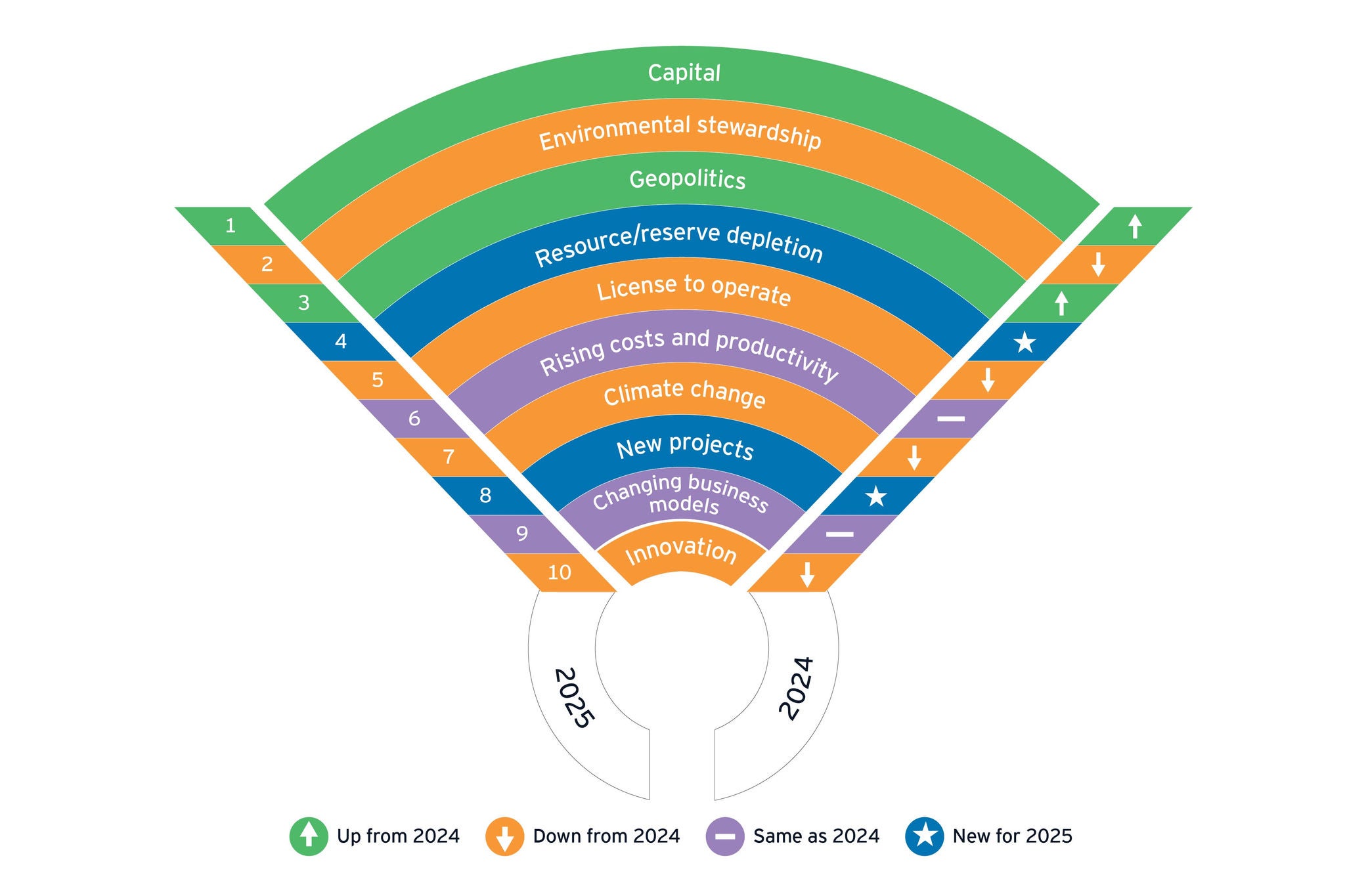Four risks fell out of the top 10 in this latest survey — governance, cyber, digital and workforce — with these omissions raising some alarm bells. For many companies, the risks and opportunities presented by cyber and digital are now integral to business as usual, not warranting particular attention. But the de-prioritization of governance was unexpected and perhaps worrying, given miners are progressing new projects in countries with potentially weaker regulatory oversight. And the loss of workforce from the radar is particularly concerning when the sector faces significant challenges in attracting and retaining the talent that will underpin its future.
Rapid transformation is now urgent. This means that 2025 must be a year of action for miners. It’s time to review and adapt current business models, consider new ones, and push ahead with the partnerships and innovation that will enable the sector to meet demand in a sustainable, optimal way.
Analysis: Top 10 risks and opportunities in mining
1. Capital
Miners continue to face increased scrutiny from investors on how investment is deployed, with a strong focus on capital discipline and returns.
Against this backdrop, companies are accelerating growth and amplifying value through mergers and acquisitions (M&A), spinning off noncore assets or high-growth assets. In a recent EY CEO Outlook Pulse Survey, all mining and metals respondents said they plan to undertake some form of transaction over the next 12 months. Companies surveyed for the top 10 business risks and opportunities report told us they are also expanding their financing options, considering an average of four sources of capital.
With challenging macroeconomic circumstances likely to continue, it’s not surprising that mining companies may want to consider partnerships, joint ventures (JVs) or integration to mitigate risk on large-scale projects. But enabling the investment required to meet demand could call for more fundamental changes to the sector’s approach to financing — thinking beyond yield and investing capital to create long-term value.
2. Environmental stewardship
The “E” in environmental, social and governance (ESG) is a key focus for mining companies, with evidence of a significant uplift in efforts to create a positive environmental legacy. Waste and water remain a priority, with our survey showing miners are pursuing innovative projects to capture value.
The push toward nature positive — the goal to halt and reverse nature loss by 2030 — has been led by the International Council on Mining and Metals (ICMM), and almost half of our survey respondents say they are confident of meeting their nature-positive obligations. The knowledge and sustainable land management experience of Indigenous communities make them essential partners in meeting these goals. An estimated quarter of the earth is in the care of Indigenous communities, and these areas are in better environmental shape than others.1
3. Geopolitics
Resource nationalism continues to rise, impacting tax rules and ownership rights.
Encouraging the large-scale projects needed to enable the energy transition will depend on governments balancing current national revenue goals with long-term benefits.
Miners may need to consider different approaches to projects in certain geographies. For example, JVs with local companies and licensing can help derisk investment.
4. Resource and reserve depletion (new entry)
Mining companies must continue to develop better ways to extract and optimize critical minerals and metals to meet soaring demand, while also protecting our environment.
This complicated problem is driven by interwoven factors. Declining ore grades increase the costs of extraction. Exploration budgets are up, but so are costs, and fewer discoveries are being made.
Mining companies are considering a mix of solutions, including investing in technologies that can advance exploration and improve productivity. For example, leaching technology can recover more metals from lower ores than traditional processes. For example, Rio Tinto’s Nuton technology can achieve recovery rates of up to 85%.2
5. License to operate
Enhancing community impact and Indigenous trust remains high on the agenda of miners and investors. Around the world, communities and governments expect miners to do more to support communities now and leave a positive legacy for the future.
Companies that empower Indigenous communities as partners are creating the foundation for long-term relationships and strengthening the brand. Mine closure is another opportunity to strengthen community relationships and leave a positive legacy but only 5% of our respondents see it as a key issue.
6. Rising costs and productivity
Miners continue to face high costs, particularly around labor and energy. Workforce expenses are exacerbated by skills shortages, impacting productivity and potentially elevating safety risks, as less qualified people take on roles.
More than a third of respondents agree that the focus on ESG (and pressure to meet growing regulatory obligations) is distracting from productivity. This highlights the benefits of integrating environmental metrics (e.g., carbon intensity) into broader productivity measures, to help mining companies reap wider benefits.
7. Climate change
Scrutiny around Scope 1 and 2 emissions is growing but so is mining companies’ confidence in hitting reduction targets, a result perhaps partly driven by progress in decarbonizing operations. Mine-site emissions intensity has declined by about 10% since 2020, mostly through the use of renewable energy.3
Net-zero targets are a different story. Many companies are piloting the production of low-carbon metals, but commercializing this technology remains difficult, partly due to costs but also insufficient hydrogen electrolyzer capacity. For example, producing a tonne of steel with hydrogen requires ~300MW of electrolyzer capacity running continuously; however, current global capacity has only just reached 1GW.4 Partnering with equipment manufacturers could help accelerate the scaling up of innovative technology that will be critical to cut emissions.
8. New projects (new entry)
Over the next 30 years, the sector will need to mine more mineral ores than humans have mined over the last 70,000 years.5 Filling the demand gap requires overcoming multiple complex barriers to new projects. Regulatory red tape is lengthening project lead times. High costs make new mines more capital intensive, and a lack of skilled workers means timely project delivery is difficult. Additionally, the increasing rate of mining royalties and taxes in some markets can be a barrier to new projects.
Miners are taking diverse approaches to overcoming these hurdles, including connecting with stakeholders during initial project stages to resolve conflicts and expedite approvals. Integration across the supply chain can also streamline activities from exploration to production and enable more accurate demand planning.
Over the next 30 years, the industry will need to mine more mineral ores than humans have mined over the last 70,000 years, to meet the exponential demand for minerals critical to the energy transition.
9. Changing business models
In their quest to capture more value, mining and metals companies are reassessing business models, with many focusing on the opportunities of sustainability. Almost half of survey respondents are considering how to integrate recycling into operations, which may include making better use of scrap or establishing collection networks.
Other companies are exploring integration across the value chain to both accelerate decarbonization and tap into new revenue. For example, investment in smelting gives mining companies greater control over emissions and creates opportunities by offering premium, cleaner products. Local partnerships can also build long-term organizational and societal value.
10. Innovation
Sustainable, cost-effective mining at scale will not happen without innovation, particularly as resources deplete, costs rise, talent becomes scarce and environmental pressures increase.
While over half of respondents anticipate more investment in innovation in the next 12 months, we see many focusing on lower-risk projects (i.e., processing). Despite the need for more discoveries, only 30% of respondents see innovation in exploration and extraction as having the potential to make a big impact.
Collaboration is integral to innovation. Partnerships between mining, industry associations and other sectors have led to breakthroughs that could yield significant economic and sustainability benefits. There are some exciting examples of the sector working with others, including collaboration between Rio Tinto, BHP, Caterpillar and Komatsu to test large battery-electric haul truck technology in the Pilbara (Western Australia).6 But despite these encouraging initiatives, 50% of survey respondents still believe there is not enough collaboration to drive innovation in the sector.
Summary
Top 10 risks and opportunities for mining and metals companies in 2025 reveals the sector is ready to embrace the transformation needed to meet soaring demand in a changing energy system. Miners that make significant, transformative changes to their business can reshape their future with confidence, accelerate paths to new value and gain competitive advantage.




